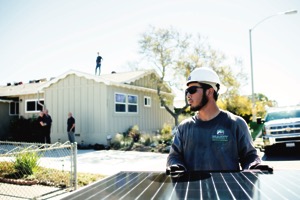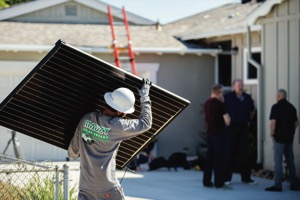
Driving through the neighborhoods of San Diego, it becomes nearly impossible not to take notice of the increasing number of solar panels adorning the rooftops of homes up and down the sunny streets.
Solar panels, known as photovoltaic (PV) systems, provide the technology used to convert the sun’s energy into usable electrical power as well as the mounting, cabling and other electrical accessories needed to manage and meter the distribution of the claimed electricity into the power grid.
Such technology was once very expensive and cost prohibitive for most homeowners. However, with tax incentive programs for purchases, lease to own plans, and Power Purchase Agreements (PPA), homeowners can more easily afford equipment costs, installation and maintenance while also reducing their energy costs and increasing their property value.
A study, titled “Understanding the Solar Home Price Premium: Electricity Generation and ‘Green’ Social Status” was published by the National Bureau of Economic Research. It reported that for the average installation, solar panels added a $20,194 premium to the sale price of the house based on repeat sales data.
Determining the best approach for acquiring solar panels can be complex and confusing. San Diego Gas & Electric provides a useful tool in determining if your household’s usage is well suited for solar power. The Solar Calculator provides potential costs and savings by going online in customer’s ‘My Account’ under the ‘My Energy’ tab and clicking “Save with Solar Energy.” Many solar contractors also provide useful online tools to show how much consumers can save with solar energy.
For the Serra Mesa household of couple Richard Hogan and John Hurrell, who went to the San Diego Home Show in January 2016 to learn more about solar and if it would help them save money, it was a process to learn about all of the options available to them. Hogan said, “With so much information, much of it conflicting, we wanted to meet with contractors and vendors in person.”
Installation of solar panels does require meeting certain criteria in order for it to be feasible. First, homes must have enough clear and unobstructed access to sunlight for most if not all of the day. The house roof needs to have a large enough area to accommodate the system. West and south facing rooflines are best suited for the panels. And finally, financial considerations including tax incentives and home appreciation should allow for the investment to pay for itself.
Hogan added, “Despite it being a two to three-month process, the tax incentive and energy savings made it a valuable investment that ultimately will add equity to our home.”
In December 2015, the United States Congress passed legislation, the Consolidated Appropriations Act, which extended the 30 percent credit for residential solar to Dec. 31, 2019. To take advantage of this credit, homeowners must buy or finance their solar panel system. When leasing solar equipment under a program, the leasing company receives the tax credit and not the homeowner.

Several programs are in place to assist homeowners with financing a solar panel system for their home. The two most common are Property Assessed Clean Energy (PACE) programs and home equity loans.
San Diego owned and managed Mauzy (www.mauzy.com) operates with a core philosophy of delivering both quality products and quality service at competitive prices for homeowners. Third generation owner Cody Mauzy said, “PACE and local credit union financing have great rates and allow homeowners to finance these projects over various terms with no money down. Essentially fixing their energy costs for the term selected and then have no payment or energy bill after the loan is repaid.”
Homeowners Hurrell and Hogan are pleased with their investment. Hogan said, “We are super happy we went with Mauzy in part because they are a local company who support our community. They are straightforward and the customer service has been amazing.”
Under Property Assessed Clean Energy (PACE), local governments create property tax finance districts to issue loans to homeowners for renewable energy such as solar PV systems. Payment takes place through your normal property tax bill to repay the loan under a low and fixed interest rate.
San Diego based Renovate America’s HERO Program (Home Energy Renovation Opportunity) partners with your local government to offer a unique, more affordable financing option using PACE. Additionally, the program qualifies equipment providers and installation contractors so that the homeowner simply applies for the program through an approved contractor or Renovate America.
As an alternative to financing the solar panel system, two similar yet different options are available to homeowners: Power Purchase Agreements (PPA) and solar leases.
With a PPA, a third party owns and provides all maintenance to the customer’s solar panel system. It sells solar generated electricity back to the customer. Customers who opt for a PPA typically have lower electricity costs that is at a fixed rate or with incremental annual rate increases. However, under a PPA there are no federal or state tax benefits. Generally, homeowners must have excellent credit to qualify. Terms range from 15 to 20 years.
Michael Leeper, director of operations for Hibrid (www.gohibrid.com), a San Diego Solar contractor offering homeowner PPA deals, HERO and financing programs through partners such as GreenSky, said “It’s advantageous to use a PPA agreement because there is no upfront cost, reduces your energy bill and is good for the environment.”
However, PPA program solar panel systems may not be right for all households. Leeper said, “For customers whose bill is more than $100 per month, typically there is a reduction of 35 percent off the electric bill. PPA agreements are usually not cost effective for people on CARE or for homes with electric bills under $100 per month.”

By leasing a solar panel system, homeowners can get the benefits of the system without the capital costs. Those opting for solar leases simply rent the solar panel system from a company while earning the benefits from the electricity the system produces. With a lease there is no payment for any of the power generated by the solar panels. Solar panel power is technically free, but homeowners have a set lease payment that rises 3 to 4 percent a year. That is typically less than the 5 percent rate increases that can be imposed by the electric company each year. Some programs offer a flat rate with no yearly increases. For leases, homeowners can expect a term of 15-20 years and must have excellent credit.
Cody Mauzy commented, “Solar is great because it allows the homeowners to take advantage of the sun individually on their home and contribute to making a cleaner planet for everyone. It also allows them to escape rising energy costs from their local utility company and in most cases eliminate kWh charges completely.”
Solar panel systems offer significant savings in energy costs. However, acquiring the equipment offers challenges to homeowners for finding the right program for their circumstances as well as considering financial goals and constraints.












Important to add that leases and PACE programs can be detrimental to homeowners. It’s often impossible to sell a home with a solar lease or PACE lein, and impossible to refinance with a PACE lein. Leases are very costly and you lose your tax credit. Lots to consider when shopping for solar.
Mylene, some PACE providers do make it difficult to sell, transfer or refinance with a PACE loan. However the HERO folks have a division dedicated to helping homeowners work though sales, transfers or refinancing. HERO will also subordinate to mortgage lenders when refinancing so that the mortgage lender can re-assume first position on the home. Its not nearly as difficult as the lenders make it seem. I understand their position but HERO makes it easy and will work directly with the lender.